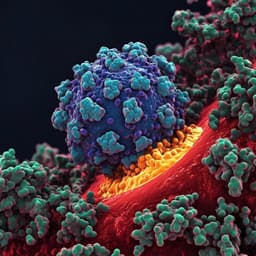
Medicine and Health
The establishment of COPD organoids to study host-pathogen interaction reveals enhanced viral fitness of SARS-CoV-2 in bronchi
L. L. Y. Chan, D. E. Anderson, et al.
This groundbreaking study by Louisa L. Y. Chan and colleagues uncovers crucial insights into chronic obstructive pulmonary disease (COPD) through novel organoid models. By establishing nasopharyngeal and bronchial organoids from healthy and COPD patients, researchers reveal significant alterations in cellular behavior and heightened inflammatory responses to infections, providing a new perspective on host-pathogen interactions in the lungs.
~3 min • Beginner • English
Related Publications
Explore these studies to deepen your understanding of the subject.







